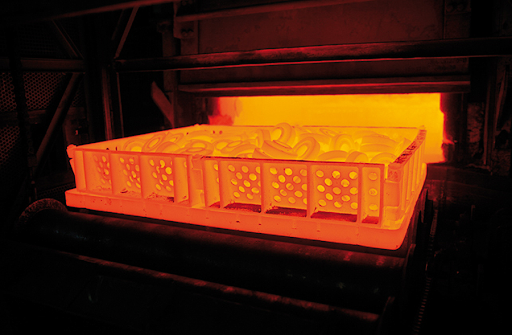Common Heat Treatment Processes For Stainless Steel Forgings
In drop forging process, stainless steel is one of the common forged materials. After forging, heat treatment is generally operated to release the stress and ease further machining job. CFS Forge, an experienced drop forging company in China, can customize stainless steel forgings with various heat treatment processes.
Solid solution treatment: heating stainlesss steel forgings to solid melting temperature (1050 ~ 1100℃), making all carbide and cold processed Martensite melt into austenite, then fast cooling. This type of heat treatment can obtain the most soft and plastic effect.
 Stress relaxation treatment: the mechanical properties of stainless steel forgings can be improved by eliminating the internal stress (275 ~ 450℃, 0.5 ~ 2h).
Stress relaxation treatment: the mechanical properties of stainless steel forgings can be improved by eliminating the internal stress (275 ~ 450℃, 0.5 ~ 2h).
Stabilization treatment: Heat stainless steel forgings to 900℃ to melt most of the chromium carbide, so that the chromium carbide no longer precipitation in the intercryst.
Eliminate σ-phase treatment: When high chromium austenitic stainless steel forgings contain insufficient nickel, σ-phase may occur during heat treatment of stainless steel forgings, resulting in a decrease in the impact toughness of the steel. Therefore, the σ-phase formation temperature (500 ~ 970℃) should be avoided during heat treatment.
In common, heat treatments for martensitic stainless steel forgings include: annealing treatment, quenching treatment, and tempering treatment.
The microstructure after annealing treatment is rich in chromium, which has low mechanical properties and poor corrosion. Therefore, in most cases, this type of forgings is used after quenching and tempering.
Due to the different performance requirements of various forgings, tempering temperature is not the same. Stainless steel forgings that need to bear impact load should be kept away from tempering within 370 ~ 600℃.
Ferritic stainless steel forgings after annealing have good plasticity and corrosion resistance, but not high strength, good welding and forming performance.Ferritic stainless steel forgings have no phase transition.Therefore, the only heat treatment is recrystallization annealing.
Recrystallization annealing is designed to remove stress, uniform and stabilize the tissue. Recrystallization annealing temperature is usually taken within the range of 700 ~ 800℃ and then cooled in air. Ferritic stainless steel forgings that need to bear impact load should be kept away from tempering within 370 ~ 600℃.
The heat treatment of precipitation hardened stainless steel forgings includes three processes: solid solution treatment, adjustment treatment and aging treatment.
Solid solution treatment: The treatment process is 1000 ~ 1030℃, LH, air cooling. The obtained tissue is austenite with a small amount of ferrite.
Adjustment treatment: The purpose of adjustment treatment is to obtain a certain amount of martensite to strengthen the steel.
Aging treatment: It is another way to strengthen precipitated hardened stainless steel forgings. When the aging temperature is higher than 400℃, intermetallic compounds will be precipitated from the martensite in a highly dispersed distribution, playing the role of precipitation hardening. Generally aged at 500℃, high hardness and strength can be obtained.
Austenitic Stainless Steel Forgings
Solid solution treatment: heating stainlesss steel forgings to solid melting temperature (1050 ~ 1100℃), making all carbide and cold processed Martensite melt into austenite, then fast cooling. This type of heat treatment can obtain the most soft and plastic effect.

Stabilization treatment: Heat stainless steel forgings to 900℃ to melt most of the chromium carbide, so that the chromium carbide no longer precipitation in the intercryst.
Eliminate σ-phase treatment: When high chromium austenitic stainless steel forgings contain insufficient nickel, σ-phase may occur during heat treatment of stainless steel forgings, resulting in a decrease in the impact toughness of the steel. Therefore, the σ-phase formation temperature (500 ~ 970℃) should be avoided during heat treatment.
Martensitic Stainless Steel Forgings
In common, heat treatments for martensitic stainless steel forgings include: annealing treatment, quenching treatment, and tempering treatment.
The microstructure after annealing treatment is rich in chromium, which has low mechanical properties and poor corrosion. Therefore, in most cases, this type of forgings is used after quenching and tempering.
Due to the different performance requirements of various forgings, tempering temperature is not the same. Stainless steel forgings that need to bear impact load should be kept away from tempering within 370 ~ 600℃.
Ferritic Stainless Steel Forgings
Ferritic stainless steel forgings after annealing have good plasticity and corrosion resistance, but not high strength, good welding and forming performance.Ferritic stainless steel forgings have no phase transition.Therefore, the only heat treatment is recrystallization annealing.
Recrystallization annealing is designed to remove stress, uniform and stabilize the tissue. Recrystallization annealing temperature is usually taken within the range of 700 ~ 800℃ and then cooled in air. Ferritic stainless steel forgings that need to bear impact load should be kept away from tempering within 370 ~ 600℃.
Precipitation-hardening Stainless Steel Forgings
The heat treatment of precipitation hardened stainless steel forgings includes three processes: solid solution treatment, adjustment treatment and aging treatment.
Solid solution treatment: The treatment process is 1000 ~ 1030℃, LH, air cooling. The obtained tissue is austenite with a small amount of ferrite.
Adjustment treatment: The purpose of adjustment treatment is to obtain a certain amount of martensite to strengthen the steel.
Aging treatment: It is another way to strengthen precipitated hardened stainless steel forgings. When the aging temperature is higher than 400℃, intermetallic compounds will be precipitated from the martensite in a highly dispersed distribution, playing the role of precipitation hardening. Generally aged at 500℃, high hardness and strength can be obtained.


 sales@dropforging.net
sales@dropforging.net